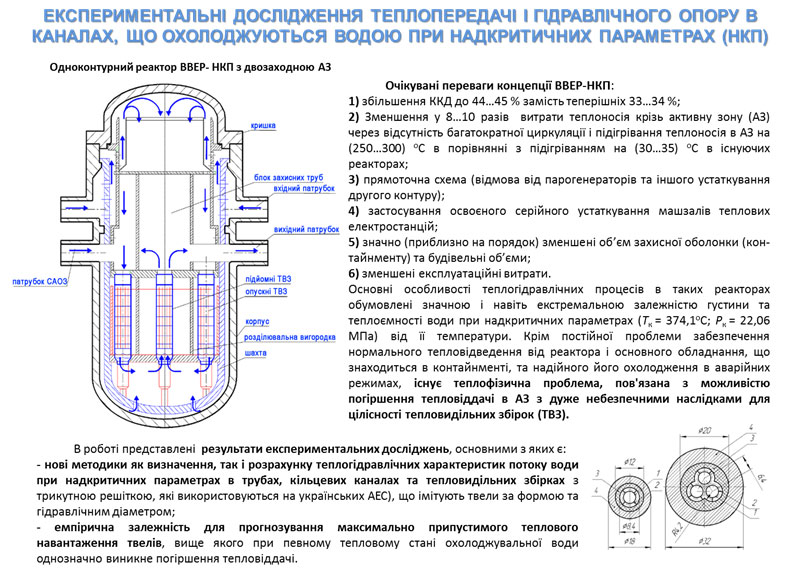Investigation of heat transfer in the simulators of fuel bundles and passive heat-removal systems for strengthening of safety barriers in nuclear power engineering
Statement and performance of the research under consideration are substantiated by: (1) vital necessity of support and strengthening of safety barriers in nuclear power engineering by passive methods heat removal; (2) availability of vaporization-and-condensation type (VCT) systems creation for heat removal and thermal shielding; (3) significant limitation of the noted R&D and absence of its implementation in nuclear power technologies; (4) extremely insufficient experimental data base as to core temperature mode in the SCW reactors of a new generation resulting in absence of reliable empirical correlations for prediction of allowable, i.e., core safe thermal loads to provide higher thermal efficiency of power units and thus to decrease specific capital investments into NPP construction.
New approach to estimation heat transfer in fuel rods by using their experimental thermohydraulic characteristics was developed. CFD modeling (analytical and differential procedures of 3-D computational hydrodynamics) of thermohydraulic phenomena consisted in testing of FLUENT, DNS, and TEMPA-SC computational codes, k-ε model modification that gave the possibility to obtain the information on internal reasons of heat transfer under supercritical pressure of water SCW). The results of CFD confirmed adequacy of the physical concept of deteriorated heat transfer (DHT) under certain SCW parameters in heated channels due to thermal acceleration of flow causing its laminarization and thermal resistance increasing in near-wall layer. Experimental investigation of DHT modes in tubes, annuli, and simulator of 3-rod fuel assembly revealed that despite widespread conclusion on impossibility of such modes under downward flow of coolant (and, in particular, of SCW) under certain conditions they take place in such cases but under higher thermal load of a channel. Another important conclusion consists in that DHT is dangerous, first of all, not by so high absolute level of wall temperature, as its strong dependence upon even insignificant change in operating conditions. For iterative prediction of the temperature mode in tubes, annuli, and simulator of 3-rod fuel assembly under up- and downward flow of SCW the system of two correlations was derived. The relationship determining heat flux qb, exceeding of which leads to DHT in the said channels, was obtained.
Basing on the investigated regularities of thermophysical factors’ impact on a heat transferring ability of a medium the correlations determining the main heat engineering properties of the VCT systems of passive heat removal were deduced. The general rules and principles of thermal calculations related to relevant thermal designs of such systems are defined. The relationships for prediction of an optimal ratio of zones’ length corresponding to the minimal thermal resistance of heat exchanging system to heat transfer are obtained.
The performed investigations of heat engineering properties of the model samples of elongated VCT heat conductors enabled to find their high heat transferring ability, steady and reliable operation, as well as compliance of their ability with thermal load for the systems of heat removal and thermal shielding that could be created on the basis of similar heat transferring elements (HTE) of fire thermal mode revealed that fire durability limit of metal structures with approximately 5-mm fire-protection coating and shielded with VCT THE exceeded 1 hr, while without VCT THE it was about 15 min.
Specific technological solutions providing efficiency and reliability of VCT passive heat-transferring system operation are developed. Original schemes and designs of VCT passive heat-transferring systems to maintain integrity of the barriers of nuclear reactor safety, to provide storage of depleted fuel, and to provide thermal shielding of building metal structures of power-supplying facilities under extreme conditions developed and protected by the patents of Ukraine.

| Attachment | Size |
|---|---|
| 318.94 KB |




